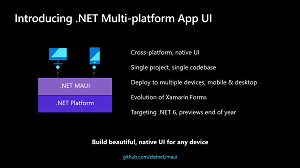News
Xamarin.Forms 5 Preview Ships Ahead of .NET 6 Transition to MAUI
Microsoft shipped a pre-release version of Xamarin.Forms 5 ahead of a planned transition to MAUI, which will take over beginning with the release of .NET 6 in November 2021.
MAUI, unveiled in May, stand for .NET Multi-platform App UI and is the evolution of Xamarin.Forms for creating native cross-platform apps with .NET. It will be used for the development of Android, iOS, macOS and Windows apps.
Xamarin.Forms will continue to be updated until .NET MAUI arrives with .NET 6, after which it will only receive priority servicing for one year.
 [Click on image for larger view.] MAUI Overview (source: Microsoft).
[Click on image for larger view.] MAUI Overview (source: Microsoft).
While it's still in the planning and early development stages, Microsoft said the dev team's goals for MAUI include:
- Improve app performance
- Improve simplicity of control extensibility
- Improve simplicity of contributing
- Enable developer options to use Model-View-Update (MVU) and Blazor
The differences between Xamarin.Forms and MAUI are illustrated here:
 [Click on image for larger view.] MAUI Compared to Xamarin.Forms (source: Microsoft).
[Click on image for larger view.] MAUI Compared to Xamarin.Forms (source: Microsoft).
In an FAQ that asks the question "Should I upgrade my Xamarin.Forms applications to .NET MAUI?" Microsoft says: "Initially, we recommend you explore .NET MAUI on new projects. We are working to make the transition from existing projects as seamless as possible as you will enjoy project system improvements, a new .NET, and a new renderer architecture in .NET MAUI."
So, as early previews for MAUI are expected late this year, Xamarin.Forms itself continues to evolve with the pre-release v5.
"Xamarin.Forms 5 brings to stable release features that you have seen in preview over the latest several 4.x releases," Microsoft's David Ortinau, principal program manager, Mobile Developer Tools, said in a Sept. 29 blog post. "This includes solid and gradient Brushes, CarouselView, drag-and-drop, RadioButton, Shapes, and SwipeView. These new features inject new creative potential for your application designs to create beautiful, interactive experiences."
For coverage of those 4.x releases, see:
Ortinau advised developers who are considering updating their apps to Xamarin.Forms 5 to be aware of changes including:
- Visual Studio 2019 is the minimum version to use
MasterDetailPage and properties have been renamedUIWebView has been removed to address Apple restrictionsMediaElement and Expander have been moved to the Xamarin Community Toolkit. C# UI is to follow.- (Preview) DataPages and Theme packages have been removed from the NuGet release
More information is found in the release notes.
Ortinau also pointed to further guidance on the new features and changes:
About the Author
David Ramel is an editor and writer at Converge 360.